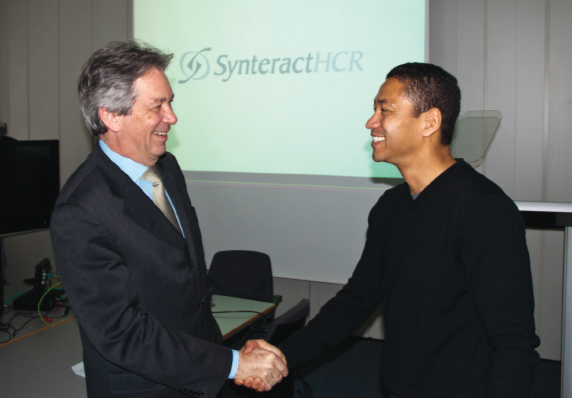Acquisition Puts SynteractHCR in Position for Global Trials
One of Southern California’s largest contract research organizations Synteract Inc. recently doubled in size after acquiring Munich, Germany-based Harrison Clinical Research Group GmbH. The move has formed a new multinational company called SynteractHCR, with headquarters in Carlsbad.

Dr. Francisco Harrison, left, founder of Harrison Clinical Research, shakes hands with Wendel Barr, CEO of SynteractHCR. Synteract’s acquisition of Munich, Germany-based Harrison Clinical Research Group GmbH gives it a much bigger global presence.
This merge is just one instance of the sea change that has been going on in the pharmaceutical industry: Drug developers are outsourcing much of their lab and clinical trial work to companies like SynteractHCR.
“As the outsourcing increases, there’s going to be a need for CROs to grow—to fill in the research gaps for pharmaceutical companies on a global scale,” said Wendel Barr, CEO of SynteractHCR.
Though financial terms of the acquisition were not disclosed, SynteractHCR said it now has a yearly revenue that exceeds $100 million. It employs 220 locally and 800 around the world.
A contract research organization, or CRO, provides ancillary research support to the pharmaceutical, biotechnology and medical device industries on a contractual basis. Both large and small pharmaceutical companies have differing reasons to outsource. Smaller companies may not have the facilities or manpower to conduct large clinical trials—as for larger companies, it’s a way to cut in-house costs.
150 Local CROs
San Diego now boasts more than 150 contract research organizations, said Joe Panetta, president and CEO of biotechnology trade association Biocom. The market for CROs in 2010 was about $21 billion and continues to grow, according a recent report from GBI Research. This accounts for almost one-third of all pharmaceutical and biotech research and development spending, according to the Association of Clinical Research Organizations, a Washington, D.C.-based nonprofit trade group for CROs.
The privately held Synteract was founded in 1995 in Carlsbad. It has historically focused on smaller to midsize pharmaceutical companies, but also does work for medical device and diagnostics companies.
“For SynteractHCR, we started to think more about our growth, and one area we felt we were lacking was the ability to do global trials,” Barr said. “We had to make a decision, and ours was we wanted to expand our capabilities in Europe because there was a high need from our clients.”
He said that the company was very successful with smaller, localized early clinical trials. However, when it came to the global clinical trials that required larger patient pools, Synteract could no longer work with the client on the proper scale.
Following the merge, the company now has offices in 16 countries, with operations in Western and Eastern Europe, Israel, South America and the U.S. Barr said that he expects to expand into Asia over the next few years as well.
It also added two new offices on the East Coast in Research Triangle Park, North Carolina and Princeton, New Jersey, reflecting coverage of three important biopharmaceutical hubs and key locations in CRO expansion.
CRO Development
A variety of factors brought about a boom in CRO development in the past few years—particularly the recent wave of downsizing in the medical research sector, Panetta said. There were biotechnology funding challenges, pharmaceutical companies were consolidating and of course, there was the recession—which led to a rash of people on the job market that had a broad expertise in various areas.
“At the same time, there was a sector in San Diego that wasn’t very mature yet in terms of the depth of talent in developing products to commercialization,” Panetta said. “So instead of scientists going to biotech companies, they started joining or even forming contract research organizations.”
Chris Viehbacher, CEO of pharmaceutical giant Sanofi SA, told Xconomy’s Luke Timmerman last year that about 70 percent of its $6.5 billion research and development budget was done in-house. His objective, however, is to bring that to a 50/50 balance of internal-to-contractual.
Research from the Tufts Center for the Study of Drug Development, an independent nonprofit research group affiliated with Tufts University, has shown that CROs are able to conduct clinical trials up to 30 percent faster than the average large pharmaceutical company. Saving time saves money, which is critical for drug development—current estimates place drug development at about $1.3 billion to $1.5 billion per medication.
“All of the pharmaceutical companies are now moving to a network research model, looking to outsource up to 50 percent of their discovery efforts,” said Robert Brown, senior director of life sciences marketing for Accelrys Inc., a San Diego-based life sciences software company.
Accelrys helps CROs, pharmaceutical companies and other biotechnology companies communicate remotely and securely—a necessity, since work is so rapidly being outsourced.
“The change is coming extremely quickly—for large pharmaceutical companies to transform their business over the course of a year or two is very, very fast compared to other things they’ve done in the past,” Brown said.
By Meghana Keshavan, San Diego Business Journal
Article was Reprinted with Permission from the San Diego Business Journal